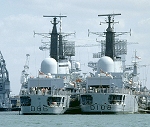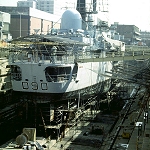Specifications
|
Batch 1 and 2
|
Batch 3
|
Displacement:
|
4,350 tons full load
|
5,350 tons full load
|
Dimensions:
|
125 x 14 x 5.8 metres (410
x 46 x 19 feet)
|
141.1 x 14.9 x 5.8 metres (463 x 49 x 19 feet)
|
Propulsion:
|
2 shafts, COGOG;
2 Rolls Royce Olympus TM3B boost gas turbines, 50,000 shp;
2 Rolls Royce Tyne RM1A cruise gas turbines, 8000 shp;
18 knots cruise, 30 knots top speed
|
2 shafts, COGOG;
2 Rolls Royce Olympus TM3B boost gas turbines, 50,000 shp;
2 Rolls Royce Tyne RM1A cruise gas turbines, 8000 shp;
18 knots cruise, 30 knots top speed
|
Crew:
|
312
|
312
|
Aviation
Helicopters:
|
1 Westland Lynx helicopter
|
Surface Action
Guns:
|
1 - 4.5"/55 Mk.8 dual
purpose single mount
|
Missiles:
|
Helicopter launched Sea Skua anti-ship
missiles
|
Radar:
|
Type 992Q/993 surface /
low level air search and target indication (replaced by Type 996 3D air
/ surface search)
Type 1006 navigation
|
Air Defence
|
Batch 1
|
Batch 2 and 3
|
Guns:
|
1 - 4.5"/55 Mk.8
dual purpose single mount
2 - 20mm single mounts (retrofitted during Falklands War)
2 - 30mm Oerlikon dual mounts (retrofitted during Falklands War)
1 - Phalanx 20mm CIWS (retrofitted during or after Falklands War)
|
same
|
Missiles:
|
1 - Sea Dart GWS30 dual
launcher
|
same
|
Radar:
|
Type 965 AKE-2 air search
(replaced with Type 1022)
Type 992Q/993 surface / low level air search (replaced by Type 996 3D
air / surface search)
|
same except Type 1022 air search in place
of Type 965 AKE-2
|
Fire Control:
|
Type 909 tracker for Sea
Dart
|
same
|
Undersea Warfare
Armament:
|
2 - STWS triple torpedo
launcher (similar to US Mk.32) firing Mk.44 or Mk.46 light ASW torpedoes (later
Stingray)
Helicopter launched Mk.44 or Mk.46 (later Stingray) torpedoes
|
Sonar:
|
Type 184M medium range
search (replaced by Type 2050 in Batch 1 and 2, Type 2016 in Batch 3)
Type 162 bottom search
|
Electronic
Warfare
Attack: 2 Type 670/675 jammer, 4 decoy, Type 182
towed decoy
ESM:
ComInt: UAA-2 intercept
Ships:
Name
|
Pendant
|
Batch
|
Completed
|
Comments
|
Fate
|
|
SHEFFIELD |
D
80
|
1
|
1975
|
Participated
in the Falklands conflict. Hit by one Exocet missile which cut fire mains,
and caused extensive fires. Sunk under tow several days later.
|
Sunk May 1982.
|
BIRMINGHAM
|
D 86
|
1
|
1976
|
|
Paid off 1999.
|
CARDIFF
|
D 108
|
1
|
1979
|
Participated in the
Falklands and Gulf War conflicts.
|
|
COVENTRY
|
D 118
|
1
|
1978
|
Participated in the Falklands
conflict. Hit by three bombs on May 25, and sank.
|
Sunk May 1982.
|
NEWCASTLE
|
D 87
|
1
|
1978
|
|
|
GLASGOW
|
D 88
|
1
|
1979
|
Participated in the Falklands conflict.
Hit by bomb that didn't explode.
|
|
EXETER
|
D 89
|
2
|
1980
|
Participated in the Falklands conflict.
|
|
SOUTHAMPTON
|
D 90
|
2
|
1981
|
Arrived at the Falklands days after
war's end, damaged by collision in the Persian Gulf in 1991.
|
|
NOTTINGHAM
|
D 91
|
2
|
1982
|
Heavily damaged in 2002 after running
aground off Australia. Floated back to the UK and repaired.
|
|
LIVERPOOL
|
D 92
|
2
|
1982
|
|
|
MANCHESTER
|
D 95
|
3
|
1982
|
Participated in the Gulf War.
|
|
GLOUCESTER
|
D 96
|
3
|
1985
|
Participated in the Gulf War. Intercepted
an Iraqi Silkworm missile headed for USS MISSOURI.
|
|
YORK
|
D 98
|
3
|
1985
|
|
|
EDINBURGH
|
D 97
|
3
|
1985
|
|
|
Photos:
(click on thumbnail for bigger image)

|
GLASGOW presumably returning from her Falklands War deployment. The black
stripe painted down her side was to distinguish her from the two Type 42 destroyers
sold to the Argentine Navy. M.D. Thomas photo. |

|
GLASGOW was the first RN ship to reach the Falklands, and did not receive
the new equipment occasioned from the lessons learned there until after her
return to the UK. She still has her original Corvus chaff launcher, along
with her boats, which were later removed to reduce topweight. M.D. Thomas
photo.
|

|
A good aft-on view of both BIRMINGHAM and CARDIFF in their original configuration.
M.D. Thomas photo.
|

|
BIRMINGHAM lowering one of her boats. These boats were replaced with inflatables
after the Falklands War to reduce topweight to allow the addition of more
equipment and weapons. M.D. Thomas photo.
|

|
Starboard
midships view of CARDIFF. The aft Type 909 tracker is under the dome to the
left, and the 8-barrelled Corvus launcher is visible at the base of the mast.
The triple STWS torpedo launcher is just aft of the boat davits, and the Type
965 AKE-2 double bedstead radar antenna is shown at the right above the forward
Type 909. M.D. Thomas photo.
|

|
A good forward view
of EXETER, with her 4.5" gun and Sea Dart launcher (with dummy missiles mounted)
forward of the bridge. The forward Type 909 tracker does not yet have its
fibreglass dome cover mounted. EXETER was the first ship fitted with the new
Type 1022 air search radar, which replaced the Type 965 AKE-2 shown in the
previous photo of CARDIFF. EXETER commissioned with this radar. M.D.
Thomas photo.
|

|
The forward superstructure and
bridge of GLOUCESTER, along with her Sea Dart launcher (with dummy missiles
mounted), Type 909 tracker dome, and Type 1022 radar. A Batch 3 ship, GLOUCESTER
has not yet received the hull lateral strengthening beam later added to her
and her Batch 3 sisters. M.D. Thomas photo.
|

|
In this photo, GLOUCESTER has
lost her port boat davits (to reflect the replacement of the boats with inflatables)
and her Corvus chaff launcher has been replaced with an new model. M.D. Thomas
photo.
|

|
LIVERPOOL is shown alongside.
She has not yet received the domes for her Type 909 trackers. M.D. Thomas
photo.
|

|
Another view of LIVERPOOL, this
time from farther aft. M.D. Thomas photo.
|

|
MANCHESTER shown alongside. She
has received the hull strengthening beam seen here on her port side at deck
level, and note the addition of the Phalanx 20mm CIWS midships alongside the
funnel. A rigid hulled inflatable boat (RHIB) can be seen just forward of
the hangar. The Type 993 radar is mounted atop the aft mast, and has not yet
been replaced by the Type 996 in this photo. M.D. Thomas photo.
|

|
NEWCASTLE with her original equipment
fit. M.D. Thomas photo.
|

|
NEWCASTLE again, this time dressed
up. M.D. Thomas photo.
|

|
A dressed SHEFFIELD
at anchor. She has not yet received the domes for her Type 909 trackers in
this photo. Note the 'Loxton Bends' on each side of her funnel; this device
was intended to reduce the ship's infra-red signature, but was apparently
not a success as no other ships of the class received them. M.D. Thomas
photo.
|

|
SHEFFIELD. M.D. Thomas photo.
|

|
SOUTHAMPTON is shown here in a
graving dock, undergoing work. M.D. Thomas photo.
|

|
YORK is shown here with her hull
strengthening beams and Phalanx mounted. Note the longer foc'st'le of the
Batch 3 over the earlier two batches. M.D. Thomas photo.
|
|

